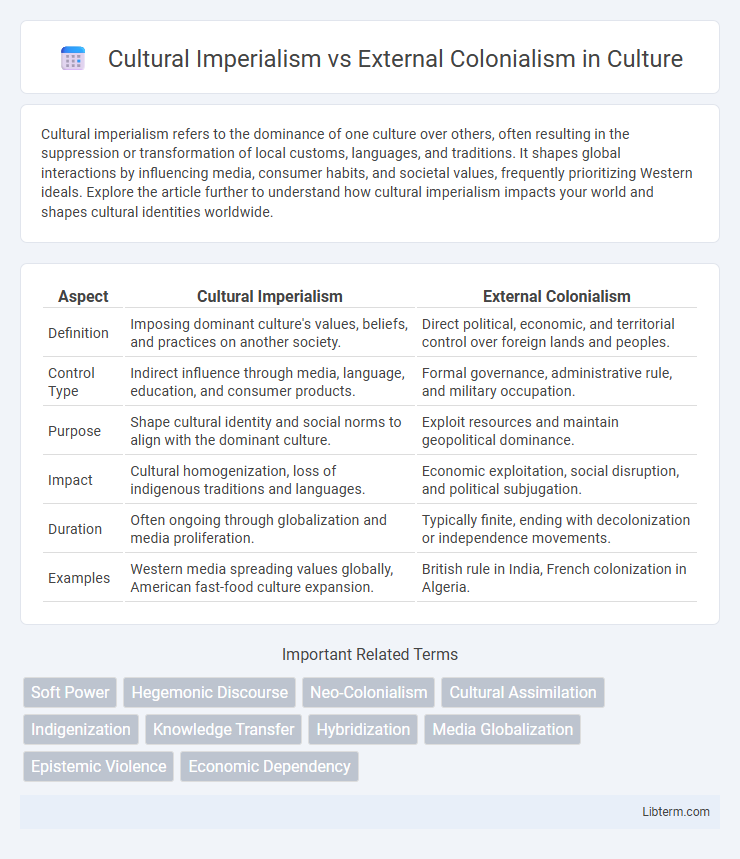Cultural imperialism refers to the dominance of one culture over others, often resulting in the suppression or transformation of local customs, languages, and traditions. It shapes global interactions by influencing media, consumer habits, and societal values, frequently prioritizing Western ideals. Explore the article further to understand how cultural imperialism impacts your world and shapes cultural identities worldwide.
Table of Comparison
| Aspect | Cultural Imperialism | External Colonialism |
|---|---|---|
| Definition | Imposing dominant culture's values, beliefs, and practices on another society. | Direct political, economic, and territorial control over foreign lands and peoples. |
| Control Type | Indirect influence through media, language, education, and consumer products. | Formal governance, administrative rule, and military occupation. |
| Purpose | Shape cultural identity and social norms to align with the dominant culture. | Exploit resources and maintain geopolitical dominance. |
| Impact | Cultural homogenization, loss of indigenous traditions and languages. | Economic exploitation, social disruption, and political subjugation. |
| Duration | Often ongoing through globalization and media proliferation. | Typically finite, ending with decolonization or independence movements. |
| Examples | Western media spreading values globally, American fast-food culture expansion. | British rule in India, French colonization in Algeria. |
Understanding Cultural Imperialism: A Modern Definition
Cultural imperialism refers to the dominance of one culture over others through the widespread dissemination of its values, media, and language, often leading to the erosion of local traditions and identities. This modern form of influence operates subtly via global entertainment, consumer brands, and digital platforms, contrasting with external colonialism's direct political or territorial control. Understanding cultural imperialism requires analyzing how cultural products and ideologies perpetuate power imbalances without the explicit use of military or governmental authority.
External Colonialism: Historical Context and Core Features
External colonialism refers to the practice where a dominant country exerts control over a foreign territory by establishing political governance, economic exploitation, and cultural dominance outside its own borders. Historically, European powers like Britain, France, and Spain expanded their empires through military conquest, settler colonization, and resource extraction during the 15th to 20th centuries, profoundly altering indigenous societies and global trade networks. Core features include direct political administration, resource exploitation, forced labor, and the imposition of the colonizer's language, religion, and legal systems on the colonized population.
Key Differences Between Cultural Imperialism and Colonialism
Cultural imperialism involves the dominance of one culture over another, often through media, language, and ideology, without direct political control, whereas external colonialism entails the physical occupation and political governance of a territory by a foreign power. The key difference lies in cultural imperialism's focus on influencing beliefs and lifestyles, while colonialism enforces economic exploitation and administrative control. Cultural imperialism operates through soft power mechanisms, whereas colonialism relies on military force and formal institutions to maintain authority.
Mechanisms of Influence: Soft Power vs Direct Control
Cultural imperialism operates through soft power by subtly shaping values, beliefs, and norms using media, education, and consumer products to influence societies without overt coercion. External colonialism enforces direct control via military presence, political governance, and economic exploitation to dominate territories and resources. The mechanisms distinguish between persuasive cultural assimilation and explicit territorial subjugation, highlighting power dynamics in global influence strategies.
Historical Case Studies: Notable Examples Worldwide
British colonial rule in India exemplifies external colonialism, where political and economic control was imposed through direct governance and resource extraction. French cultural imperialism in North Africa promoted the spread of French language and education, influencing local customs without full political domination. The United States' cultural exportation through media and consumer brands in post-World War II Japan illustrates cultural imperialism, shaping societal values while respecting sovereign governance.
Economic Dimensions: Resource Exploitation and Dependency
Cultural imperialism perpetuates economic dependency by shaping consumer behavior and local markets to favor foreign goods, reinforcing resource exploitation through multinational corporations controlling primary industries. External colonialism imposes direct resource extraction and labor exploitation, establishing structural economic inequalities that benefit imperial powers. Both phenomena result in unequal economic relationships, where resource-rich regions remain dependent on external entities, hindering sustainable development and economic sovereignty.
Language, Media, and Education as Tools of Domination
Language, media, and education serve as potent instruments of both cultural imperialism and external colonialism, enabling dominant powers to impose values and narratives that erode indigenous identities. The promotion of a colonizer's language through educational systems suppresses native languages, while media dissemination controls information flow and molds public perception in favor of hegemonic interests. These mechanisms perpetuate unequal power dynamics by reshaping cultural norms and knowledge frameworks to align with the colonizer's ideology.
Resistance and Adaptation: Indigenous Responses
Indigenous responses to cultural imperialism often involve forms of resistance such as revitalizing native languages, traditions, and spiritual practices that external colonial powers seek to suppress. Adaptation strategies include selectively integrating foreign elements to strengthen indigenous identities while maintaining core cultural values. These efforts illustrate the resilience and agency of indigenous communities in navigating the pressures of both cultural imperialism and external colonialism.
Long-Term Impacts on Identity and Social Structure
Cultural imperialism reshapes identity by imposing dominant cultural values and norms, leading to the erosion of indigenous traditions and languages over generations. External colonialism enforces political and economic control, disrupting social structures through resource extraction and hierarchical governance systems. Both forms of domination cause long-term fragmentation of community identity and social cohesion, often resulting in persistent inequality and cultural hybridity.
Navigating Globalization: The Future of Cultural Influence
Navigating globalization reveals the subtle power shifts between cultural imperialism--the dominance of one culture's values and media--and external colonialism's physical control over territories. Future cultural influence hinges on digital media platforms that propagate dominant cultural narratives while enabling resistance and hybridization in local cultures. Understanding this dynamic is crucial for policymakers aiming to balance cultural preservation with global integration in a multipolar world.
Cultural Imperialism Infographic

 libterm.com
libterm.com